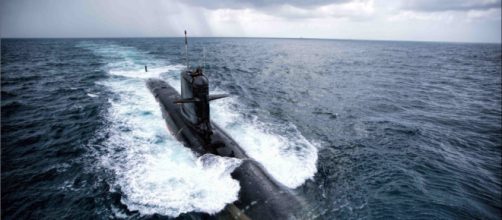India is reportedly working to improve its military readiness. The news about military readiness comes amid concerns over the increasing Chinese naval presence in the Indian Ocean and the increased tension in the India-Pakistan border. This week, the Indian military issued an all-out alert along the hotly contested Indo-Pakistan border and announced a major addition to its growing submarine force.
According to the Russian website The Sputnik News, the Indian Navy is adding its second Scorpene-class submarine to its current naval inventory. The INS Khanderi is the second of six submarines being developed in India following a transfer of submarine technology from French firm Naval Group, a French industrial group that specialized in naval defense technology and renewable energy development.
The Chinese Navy has increased its naval activities in the Indian Ocean as part of the country’s anti-piracy escort task force in the Gulf of Aden. The Chinese naval task force will provide security to Chinese merchant vessels operating in the Gulf of Aden and nearby waters. China’s naval deployment in the Indian Ocean includes a number of combat-ready vessels and submarines.
Last week, the Indian Navy has tracked down the presence of the Chinese warship, including the nuclear-powered submarine, operating near the Indian waters. The Indian Navy is currently monitoring every Chinese warship that enters the Indian Ocean. The tracking of the Chinese warships starts as soon as they enter the Indian water from the Malacca Straits.
To patrol and track the Chinese warship, the Indian Navy used the American-made P-8I maritime surveillance aircraft.
About the new Scorpene-class submarine
Originally developed by the DCNS and now by French firm Naval Group, the Scorpene is a class of diesel-electric powered attack submarines. Powering this fast attack submarine is a combination of the diesel propulsion system and air-independent propulsion technology. The submarine is capable of a speed of up to 37km/hour or 23 miles per hour (when submerged). It has a range of up to 12,000 km (when surfaced) and 1,020 km (when submerged).
As for weaponry and armament, the Scorpene submarine is capable of firing an Exocet SM39 missile, a French-made sea-skimming subsonic anti-ship missile.
The Exocet missile has an operational range of 50 to 70 km. In addition to the anti-ship missile, the Scorpene submarine also equipped with six 533-millimeter torpedo tubes used for launching sea mines and torpedoes. The submarine reportedly used Ku and S-band SATCOM communication systems, allowing the submarine to network with the rest of the Indian naval fleet. This network connectivity also allows the Scorpene to be armed with more lethal torpedoes that still under procurement.
The addition of the new Scorpene submarine to the Indian Navy is expected to beef up the country’s naval capabilities. The new submarine brings superior stealth features along with advanced technologies for tracking and destroying the enemy submarine.
The new Scorpene-class submarine was originally planned to enter into service in 2013. However, the submarine was delayed due to some technical difficulties and some issues on ship development. The Indian Navy has already told the original manufacturer, the European-based French Naval Group, about the design issues and asked to fix it at the earliest. In addition to manufacturing issues and delays, the Indian Navy is also facing some budgetary shortage.
India first announced the acquisition of the Scorpene-class submarines in 2005, buying six of the Scorpene submarines for a whopping $3 billion or $500 million per submarine. Under the technology transfer agreement with the original submarine builder, the state-owned, Mumbai-based Mazagon Docks was selected to build the Scorpene-class submarines.
The first Indian Scorpene-class submarine, the INS Kalvari, was delivered to the Indian Navy in September 2016. It was commissioned into the Indian Navy on December 2017.
Indian army on high alert over the Indo-Pakistan border
In another India military-related stories, the Indian Army and Border Security F (BSF) have been ordered to maintain a high level of alert over the drone-related intrusion. The BSF currently guard the much intense 180 km international border. The Indian Army has received an order to shoot down any unknown drone that will fly or infiltrate the Indian airspace, the Sputnik News reported.
Pakistan has reportedly made 10 drone sorties and dropped AK-47 assault rifles, narcotics, counterfeit currency in the Tarn Taran district, Punjab.
The Sputniks News has learned from the Indian Intelligence agency that the Pakistan-based Khalistani terror group has used Chinese-made drones to drop weapons and other payloads in the Indian state of Punjab. The Indian Army has already seized rifles, ammunitions, satellite phones, mobile phones and counterfeit currency from the Punjab region.


